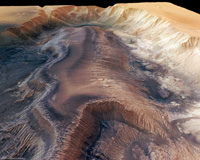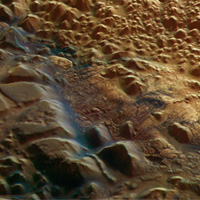What is the origin of light-toned deposits on Mars?
10 December 2008
Light-Toned Deposits (LTD) on the surface of Mars have been at the centre of scientific debate since their discovery by the Viking spacecraft in the late 1970's. In a recent paper, using data obtained with Mars Express, Angelo Pio Rossi and colleagues propose that several LTD are vestiges of large-scale spring deposits.Understanding the origin and evolution of geological features observed on the surface of planets in the solar system requires bringing together information from multiple missions, and formulating testable hypotheses about the age and composition of the features observed.
 |
|
Light Toned Deposits in Hebes Chasma. Credits: ESA/DLR/FU Berlin (G. Neukum) |
Light-Toned Deposits (LTD) have been at the centre of scientific debates since their discovery by the Viking spacecraft in the late 1970's. In particular, the age of such deposits with respect to the surrounding environment is a key element in the construction of a coherent picture of their origin and evolution.
In a recent paper published in the Journal of Geophysical Research, Angelo Pio Rossi and colleagues put forward the hypothesis that several LTD are vestiges of large-scale spring deposits.
Their hypothesis rests on a re-analysis of the age of a number of LTD, that shows them to be younger than believed so far, and the observation of several common features between LTD in different geological settings.
 |
|
Iani Chaos - another region where LTD are present. Credit: ESA/DLR/FU Berlin (G. Neukum) |
The authors identify a number of observables at several spatial scales that would confirm their hypothesis, and suggest that future in situ and remote sensing missions to the red planet could target LTD as here the conditions favourable to life and its fossilization could have arisen.
Reference publication:
Rossi, A.P., et al., Large-scale spring deposits on Mars? Journal of Geophysical Research, Vol. 113, E08016, 2008, DOI:10.1029/2007JE003062.
